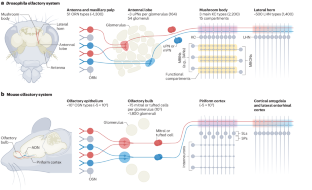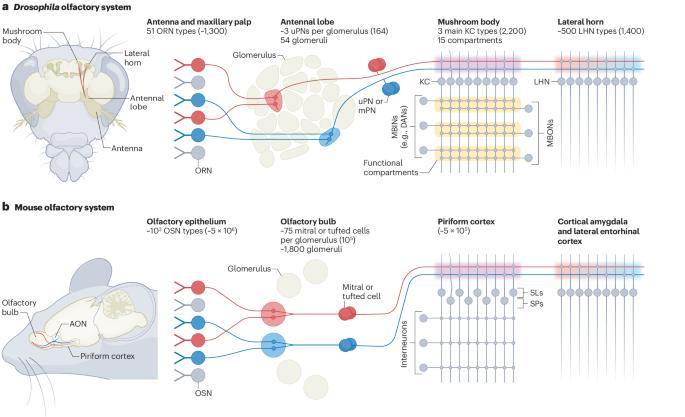脊椎动物和无脊椎动物气味编码的共同原则。
IF 26.7
1区 医学
Q1 NEUROSCIENCES
引用次数: 0
摘要
嗅觉系统是探索大脑如何将感官输入转化为行为的一个理想而易操作的系统。嗅觉系统的基本任务包括气味检测、辨别和分类。嗅觉系统面临的挑战是如何将嗅觉刺激的高维空间转化为更小的感知对象和价值空间,从而赋予气味以意义。我们目前对神经回路如何应对这一挑战的理解主要来自于对大脑处理其他感官模式(如视觉和听觉)的机制的观察,在这些感官模式中,优化的深层分级回路被用来提取沿连续物理维度变化的感官特征。相比之下,嗅觉系统使用浅层并行化的电路架构来处理不明确的高维刺激空间和离散刺激。在这里,我们将介绍最近在脊椎动物和无脊椎动物系统中观察到的现象,这些现象将嗅觉代码的统计结构和状态调制与感知和气味引导行为的机制联系起来。本文章由计算机程序翻译,如有差异,请以英文原文为准。


Common principles for odour coding across vertebrates and invertebrates
The olfactory system is an ideal and tractable system for exploring how the brain transforms sensory inputs into behaviour. The basic tasks of any olfactory system include odour detection, discrimination and categorization. The challenge for the olfactory system is to transform the high-dimensional space of olfactory stimuli into the much smaller space of perceived objects and valence that endows odours with meaning. Our current understanding of how neural circuits address this challenge has come primarily from observations of the mechanisms of the brain for processing other sensory modalities, such as vision and hearing, in which optimized deep hierarchical circuits are used to extract sensory features that vary along continuous physical dimensions. The olfactory system, by contrast, contends with an ill-defined, high-dimensional stimulus space and discrete stimuli using a circuit architecture that is shallow and parallelized. Here, we present recent observations in vertebrate and invertebrate systems that relate the statistical structure and state-dependent modulation of olfactory codes to mechanisms of perception and odour-guided behaviour. The detection, discrimination and categorization of odours are essential for survival across the animal kingdom. In this Review, Datta and co-workers describe and compare the neural circuits that mediate the processing of olfactory information and the key principles of olfactory coding in insects and mammals.
求助全文
通过发布文献求助,成功后即可免费获取论文全文。
去求助
来源期刊

Nature Reviews Neuroscience
NEUROSCIENCES-
自引率
0.60%
发文量
104
期刊介绍:
Nature Reviews Neuroscience is a multidisciplinary journal that covers various fields within neuroscience, aiming to offer a comprehensive understanding of the structure and function of the central nervous system. Advances in molecular, developmental, and cognitive neuroscience, facilitated by powerful experimental techniques and theoretical approaches, have made enduring neurobiological questions more accessible. Nature Reviews Neuroscience serves as a reliable and accessible resource, addressing the breadth and depth of modern neuroscience. It acts as an authoritative and engaging reference for scientists interested in all aspects of neuroscience.
 求助内容:
求助内容: 应助结果提醒方式:
应助结果提醒方式:


